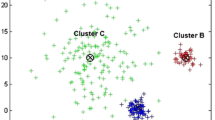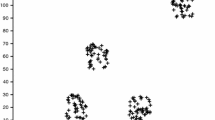Abstract
Many validity measures have been proposed for evaluating clustering results. Most of these popular validity measures do not work well for clusters with different densities and/or sizes. They usually have a tendency of ignoring clusters with low densities. In this paper, we propose a new validity measure that can deal with this situation. In addition, we also propose a modified K-means algorithm that can assign more cluster centres to areas with low densities of data than the conventional K-means algorithm does. First, several artificial data sets are used to test the performance of the proposed measure. Then the proposed measure and the modified K-means algorithm are applied to reduce the edge degradation in vector quantisation of image compression.













Similar content being viewed by others
References
Jain AK, Dubes RC (1988) Algorithms for clustering data. Prentice Hall, Englewood Cliffs, NJ
Höppner F, Klawonn F, Kruse R, Runkler T (1999) Fuzzy cluster analysis-methods for classification, Data Analysis and Image Recognition. Wiley, Chichester
Bezdek JC (1981) Pattern recognition with fuzzy objective function algorithms. Plenum Press, New York
Bezdek JC (1973) Fuzzy mathematics in pattern classification. PhD thesis, Cornell University
Dunn JC (1973) A fuzzy relative of the ISODATA process and its use in detecting compact well-separated clusters. J Cybern 3(3):32–57
Gustafson DE, Kessel WC (1979) Fuzzy clustering with a fuzzy covariance matrix. In: Proceedings of the IEEE Conference on Decision and control, San Diego, January 1979, pp 761–766
Gath I, Geva AB (1989) Unsupervised optimal fuzzy clustering. IEEE Trans Pattern Anal Machine Intell 11:773–781
Dave RN (1989) Use of the adaptive fuzzy clustering algorithm to detect lines in digital images. In: DP Casasent (ed) Intelligent Robots and Computer Vision VIII, vol 1192, part 2, pp 600–611
Dave RN (1990) Fuzzy shell-clustering and application to circle detection in digital images. Int J Gen Syst 16:343–355
Man Y, Gath I (1994) Detection and separation of ring-shaped clusters using fuzzy clustering. IEEE Trans Pattern Anal Machine Intell 16:855–861
Dave RN, Bhaswan K (1992) Adaptive fuzzy c-shells clustering and detection of ellipses. IEEE Trans Neural Networks 3: 643–662
Höppner F (1997) Fuzzy shell clustering algorithms in image processing: fuzzy c-rectangular and 2-rectangular shells. IEEE Trans Fuzzy Syst 5:599–613
Su MC, Chou CH (1999) A competitive learning algorithm using symmetry. IEICE Trans Fund Electron Commun Comput Sci E82-A(4):680–687
Su MC, Chou CH (2001) A modified version of the k-means algorithm with a distance based on cluster symmetry. IEEE Trans Pattern Anal Machine Intell 23: 674–680
Karypis G, Han H, Kumar V (1999) Chameleon: hierarchical clustering using dynamic modeling. IEEE Comput 32:68–75
Ester M, Kriegel HP, Sander J, Xu X (1996) A density-based algorithm for discovering cluster in large spatial database with noise. In: Proceedings of the 2nd International Conference on Knowledge discovery and data mining. AAAI Press, Menlo Park, CA, pp 226–231
Guha S, Rastogi R, Shim K (1999) ROCK: a robust clustering algorithm for categorical attributes. In: Proceedings of the 15th International Conference on Data engineering. IEEE Computer Society Press, Los Alimitos, CA, pp 512–521
Guha S, Rastogi R, Shim K (1998) CURE: an efficient clustering algorithm for large databases. In: Proceeding of the ACM SIGMOD International Conference on Management of data, pp 73–84
Agrawal R, Gehrke J, Gunopulos D, Raghavan P (1998) Automatic subspace clustering for high dimensional data for data mining application. In: Proceedings of the ACM SIGMOD International Conference on Management of data, Seattle, WA, June 1998, pp 94–105
Ankerst M, Breunig M, Kriegel HP, Sander J (1999) OPTICS: ordering points to identify the clustering structure. In: Proceedings of the ACM SIGMOD International Conference on Management of data, Philadelphia, PA, June 1999. ACM Press, New York, pp 49–60
Zhang T, Ramakrishnan R, Livny M (1996) BIRCH: an efficient data clustering method for very large databases. In: Proceedings of the ACM SIGMOD International Conference on Management of data, Montreal, Canada, June 1996, pp 103–114
Huntsherger TL, Jacobs CL, Cannon RL (1985) Iterative fuzzy image segmentation. Pattern Recognition 18:131–138
Dave RN, Patel KJ (1990) Progressive fuzzy clustering algorithms for characteristic shape recognition. In: IB Turksen (ed) Proceedings of the North American Fuzzy Information Processing Society on Quarter century of fuzziness, vol 1, pp 121–124
Krishnapuram R, Frigui H, Nasraoui O (1995) Fuzzy and possibilistic shell clustering algorithms and their application to boundary detection and surface approximation—I and II. IEEE Trans Fuzzy Syst 3:29–61
Jolion JM, Meer P, Bataouche S (1991) Robust clustering with applications in computer vision. IEEE Trans Pattern Anal Machine Intell 13:791–802
Frigui R, Krishnapuram R (1997) Clustering by competitive agglomeration. Pattern Recognition 30:1109–1119
Miyamoto S, Mukaidono M (1997) Fuzzy c-means as a regularization and maximum entropy approach. In: Proceedings of the 7th Fuzzy System Association World Confgress, Prague, Czech Republic, June 1997, vol 2, pp 86–92
Dunn JC (1974) Well separated clusters and optimal fuzzy partitions. J Cybernet 4:95–104
Bezdek JC (1974) Numerical taxonomy with fuzzy sets. J Math Biol 1:57–71
Xie XL, Beni G (1991) A validity measure for fuzzy clustering. IEEE Trans Pattern Anal Machine Intell 13:841–847
Davies DL, Bouldin DW (1979) A cluster separation measure. IEEE Trans Pattern Anal Machine Intell 1:224–227
Milligan GW, Cooper MC (1985) An examination of procedures for determining the number of clusters in a data set. Psychimetrika 50:159–179
Jain AK, Murthy MN, Flynn PJ (1999) Data clustering: a review. ACM Comput Surv 31:265–323
Cheeseman P, Stutz J (1996) Bayesian classification (autoclass): theory and results. In: Fayyad UM, Piatesky-Shapiro G, Smyth P, Uthurusamy R (eds) Advances in knowledge discovery and data mining. AAAI Press, Menlo Park, CA
Heckerman D, Geiger D, Chickering DM (1995) Learning Bayesian networks: the combination of knowledge and statistical data. Machine Learning 20:197–243
Hardy A (1996) On the number of clusters. Computat Statist Data Anal 23:83–96
Bandyopadhya S, Maulik U (2001) Nonparametric genetic clustering: comparison of validity indices. IEEE Trans Syst Man Cybernet Part C: Applic Rev 31:120–125
Bezdek JC, Pal NR (1998) Some new indexes of cluster validity. IEEE Trans Syst Man Cybernet 28: 301–315
Bensaid AM, Hall LO, Bezdek JC, Clarke CP, Silbiger ML, Arrington JA, Murtagh RF (1996) Validity-guided (Re) clustering with applications to image segmentation. IEEE Trans Fuzzy Syst 4:112–123
Dubes R, Jain AK (1979) Validity studies in clustering methodologies. Pattern Recognition 11:235–253
Linde Y, Buzo A, Gray R (1980) An algorithm for vector quantization design. IEEE Trans Commun 28:84–95
Gersho A, Ramamurthi B (1982) Image coding using vector quantization. In: Proceedings of the IEEE International Conference on Acoustics, Speech, and Signal Processing, Paris, May 1982. IEEE, Piscataway, NJ, pp 428–431
Baker RL, Gray RM (1982) Image compression using nonadaptive spatial vector quantization. In: Proceedings of the 16th Asilomar Conference on Circuits, systems, and computers, pp 55–61
Baker RL (1984) Vector quantization of digital images. PhD Dissertation, Stanford University, Stanford, CA
Kim YK, Ra JB (1995) Adaptive learning method in self-organizing map for edge preserving vector quantization. IEEE Trans Neural Networks 6:278–280
Park DC, Woo YJ (2001) Weighted centroid neural network for edge preserving image compression. IEEE Trans Neural Networks 12:1134–1146
Acknowledgement
This work is partially supported by the National Science Council, Taiwan, R.O.C, under the NSC 92-2213-E-008-008 and by the MOE Program for Promoting Academic Excellence of Universities under the grant number EX-91-E-FA06-4-4.
Author information
Authors and Affiliations
Corresponding author
Rights and permissions
About this article
Cite this article
Chou, CH., Su, MC. & Lai, E. A new cluster validity measure and its application to image compression. Pattern Anal Applic 7, 205–220 (2004). https://doi.org/10.1007/s10044-004-0218-1
Received:
Accepted:
Published:
Issue Date:
DOI: https://doi.org/10.1007/s10044-004-0218-1




